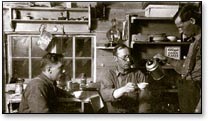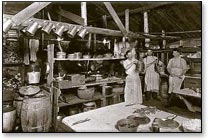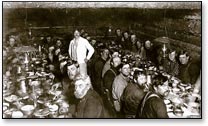Popular as the firkin was as a bulk butter container, its contents oftentimes became tainted with woody flavors. When gold was discovered in the Yukon, the affluent miners were willing to pay any price in order to satisfy their taste for fine butter. Perishable foods were unknown delicacies in the Arctic Zone. Butter, of course, was one of these perishables. Suppliers in the United States working on the problem found that butter sealed in cans from which the air had been exhausted was still creamy and fresh months later. Thus, the discovery of gold in Alaska gave impetus to the canning of butter in tin containers -- a practice that was later followed in supplying export demand and for expeditions to remote and unknown regions.
The U.S. Navy became interested in this method of packing butter and in 1912 considerable effort was made to secure a grade of canned sweet butter that could be carried for a long time in almost any climate. It took a couple of years of hard work to get the butter up to the required standard, but in 1914 substantial orders for millions of pounds of such butter were placed by the U.S. Navy, which orders were filled satisfactorily but only with the cooperation of a hundred or more plants in Iowa, Minnesota and Wisconsin. Chief Rawl of the Dairy Division of the Department of Agriculture became so interested in the development that he suggested that this sweet cream butter be put on the commercial market -- which was finally done.
Thus, today the sweet cream butter sold in many markets throughout the United States that has enjoyed an ever-increasing market had its origin in the "strike" of gold in the Yukon in 1861.



